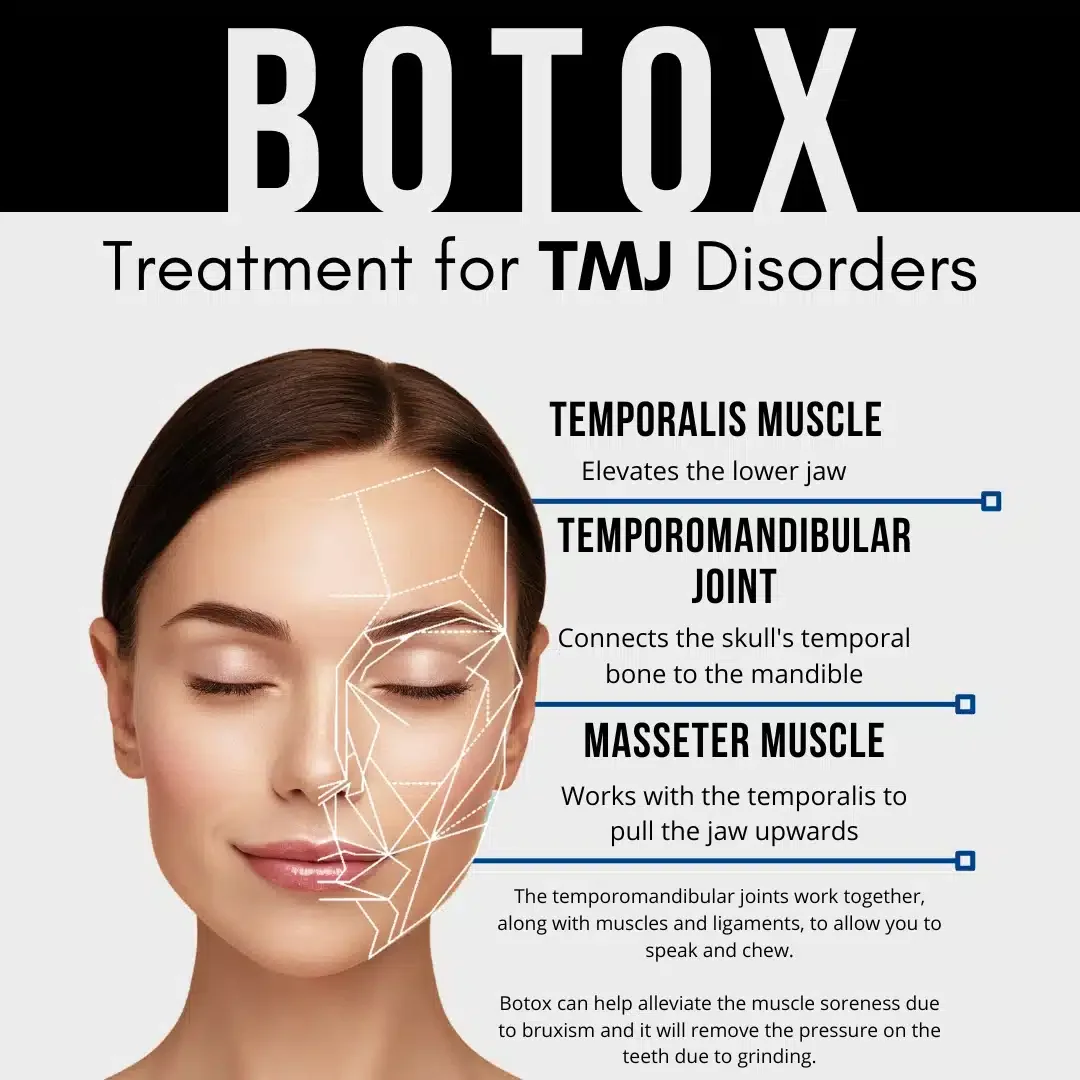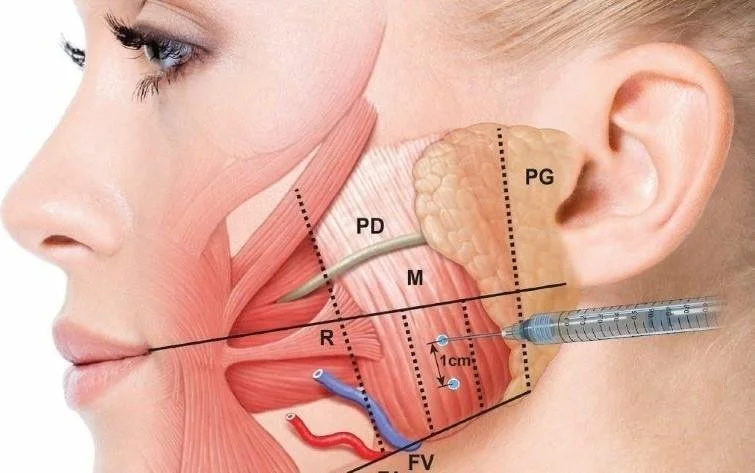Botox for TMJ Disorder: Benefits and What to Know
Do you experience facial or chronic jaw pain? Do you experience difficulty speaking, chewing, or opening your mouth wide? These could be symptoms of a condition called temporomandibular joint syndrome (TMJ). The symptoms can become disruptive in a short span of time. For many people experiencing and living with TMJ dysfunction, even daily activities like talking, yawning or eating can become a struggle. Luckily, there are treatment options available - one of which includes Botox for TMJ.
What is TMJ Disorder?
TMJ develops when the temporomandibular joint becomes inflamed or displaced due to specific stressors. The temporomandibular joint is located on each side of the head, where the jawbone connects to the skull. The TMJ allows the jaw to move forward and backward, side to side, and up and down, enabling us to yawn, chew and talk. Issues with the joint or the surrounding muscles can result in TMJ syndrome. This can cause immense discomfort and pain and can even impact the ability to open the mouth, chew or speak.
TMJ Disorder Causes
The exact causes of temporomandibular joint syndrome are unclear; however, various factors can contribute to this physical condition. Some of the common causes include:
Clenching or teeth grinding can lead to muscle strain and even damage the joint.
A direct blow to the jaw can cause jaw injury, resulting in damage to the joint.
Stress can cause the jaw muscles to tense up, possibly triggering TMJ issues.
Several forms of arthritis can impact the temporomandibular joint, potentially causing TMJ‑related issues.
Some people might have a genetic susceptibility to TMJ disorders.
What is Botox for TMJ Disorder?
Botox is an effective neurotoxin that works by preventing the nerve signals from reaching the muscles, thus temporarily relaxing them. This makes Botox an ideal use for both cosmetic and medical treatments. Regarding the role of Botox for TMJ, it can reduce pain and relieve tension in the jaw area by targeting particular muscles involved in grinding and clenching. The dose of Botox injections targets the temporalis and masseter muscles, two muscles responsible for the movement of the jaw, to help avert involuntary clenching, reducing stress and pain on the TMJ.
Remember that Botox is not a cure for TMJ syndrome, but it helps relieve symptoms by relaxing overworked jaw muscles, allowing the joint time to rest and recuperate. Many people experience improved jaw function and considerable pain relief with consistent Botox treatments.
Benefits of Botox for TMJ Syndrome
Botox provides various benefits when used for the treatment of TMJ, such as:
Minimally Invasive and Non-Surgical
Botox injections are simple, quick, and minimally invasive, providing a non-surgical alternative to people who prefer non-invasive TMJ treatments.
Reduced Tension and Headaches
Because TMJ can cause neck pain and tension headaches, Botox’s muscle-soothing effects can help alleviate these symptoms, lessening headache intensity and frequency.
Improved Jaw Mobility
Botox for TMJ makes it easier to open and close your mouth without restriction or discomfort, allowing you to yawn, talk, and chew with comfort.
Pain Relief
By relaxing the jaw muscles, Botox can ease pain and decrease tenderness in the TMJ region within days of treatment.
Fast Recovery Time
Unlike surgical alternatives, Botox involves almost no downtime. You can easily return to your normal activities immediately after your treatment.
Botox for TMJ
What to Expect During the Administration of Botox Injections for TMJ Syndrome?
If you are considering Botox for the treatment of TMJ, the treatment procedure usually looks like:
Initial Consultation
You must first consult with a qualified medical aesthetician to determine the best course of treatment. The medical aesthetician will evaluate your jaw, review your symptoms, and decide whether Botox is an appropriate treatment for you. The healthcare provider will also ask about your medical history.
Preparing for the Injection
Once you are ready for the treatment, the medical aesthetician will identify the most appropriate injection sites, focusing on the temporalis and masseter muscles. They may use a marker to identify where the Botox injections for TMJ would be inserted.
Injection Process
The injections are easy and quick to administer. A fine needle is used to ease discomfort. Most people experience just a mild sting or pinch when the botulinum is injected. Usually, the procedure takes around 10 to 15 minutes.
Post-Injection Guidelines
Once your treatment is finished, you will receive specific instructions to get the best results. Generally, these include refraining from engaging in strenuous activities on the treatment day, lying down for extended periods, and avoiding rubbing the injection site.
How Long Do the Effects of Botox Injections for TMJ Syndrome Last?
The Botox effects usually last from 3 to 6 months, depending on factors such as stress level, muscle activity, and the rate at which the body metabolizes Botox. Many people experience improvement within days of their treatment, with complete relief being felt two weeks after the procedure. Once the effects diminish, people may require additional Botox shots to sustain the results. Some individuals find they can gradually increase the interval between sessions as their symptoms subside.
Are There Any Adverse Effects Linked with Botox Injections for TMJ Dysfunction?
Generally, Botox is considered safe when administered by a qualified and experienced professional, but some modest side effects may occur. Some of the common adverse effects associated with Botox treatment for TMJ include:
Difficulty Chewing: In some rare cases, the treatment may cause slightly weakened jaw muscles, resulting in minor chewing difficulties. But this is a temporary condition and generally subsides within a few days.
Flu-Like Symptoms or Headache: Some people might experience modest headaches or slight fatigue.
Bruising or Mild Pain: Some individuals may experience bruising or little pain at the injection site. Nevertheless, this is a temporary issue that resolves quickly.
Who Should Consider Botox Treatment for TMJ Dysfunction?
Botox might be a good option for you if:
You are Considering a Non-Surgical Solution: Botox is a minimally invasive treatment that avoids the risks and downtime typically linked to surgical procedures.
You Experience Frequent Headaches and Jaw Pain: People who experience persistent headaches or jaw pain might find relief through the muscle-relaxing properties of Botox.
You Have Tried Other Options Without Results: If physical therapy, medication, or mouthguards have not relieved your symptoms, Botox treatment for TMJ dysfunction can provide the relief you require.




